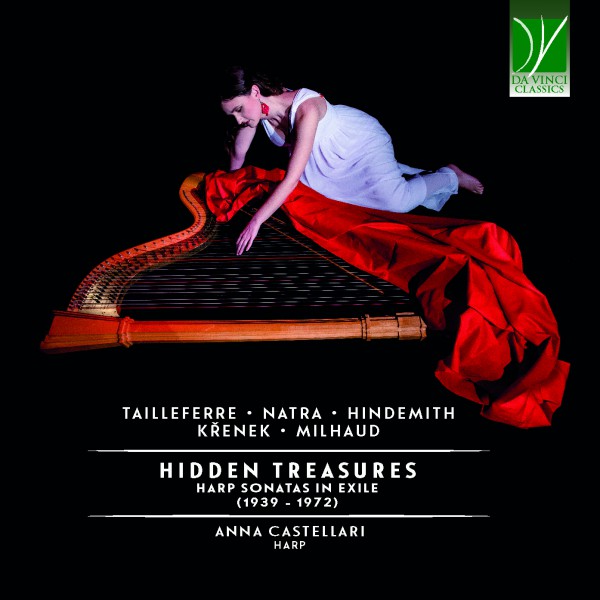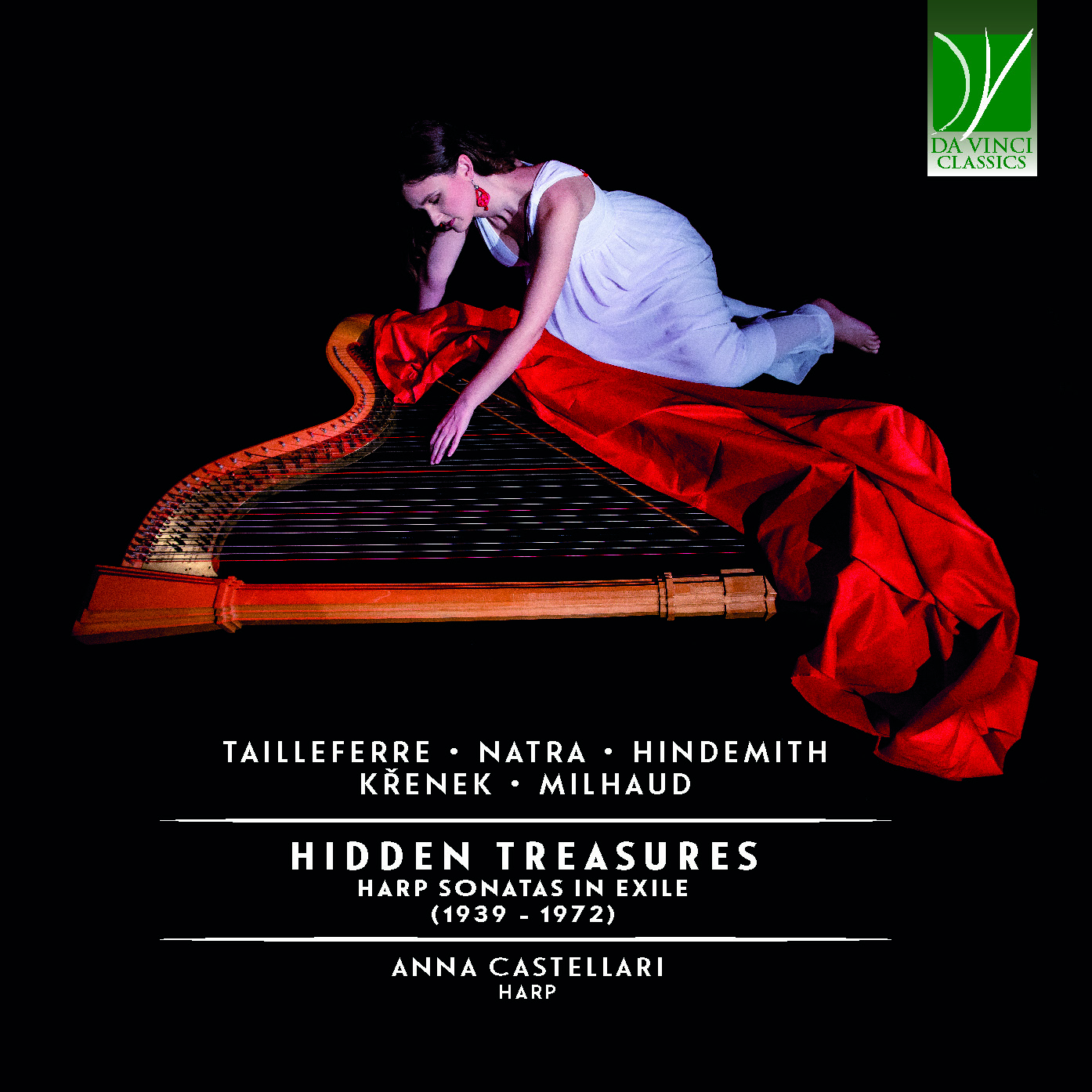
Hidden Treasures: Harp Sonatas in Exile (1939 – 1972) - Anna Castellari
-
Artist
Anna Castellari
-
Title
Hidden Treasures: Harp Sonatas in Exile (1939 – 1972)
-
Label
Da Vinci Classics
-
Authors
Darius Milhaud, Ernst Křenek, Germaine Tailleferre, Paul Hindemith, Sergiu Natra
-
Release date
2023-04-28
-
Year
2023
ENGLISH (Italian follows)
It is with great enthusiasm that Da Vinci Classics presents the new album Hidden Treasures: Harp Sonatas in Exile by harpist Anna Castellari, an extraordinary collection that offers a glimpse into some of the most significant works for harp written during the 20th century. These compositions not only represent exceptionally fascinating achievements of the musical art of the century that just ended, but also constitute examples of different schools, genres and approaches to music in general, and to the harp in particular.
Among the jewels on this album, the Sonata by Germaine Tailleferre, a composer who is experiencing a gradual but inexorable rediscovery and who demonstrates the profound mastery of her refined language and her precision in the management of harmony, counterpoint and texture, clearly stands out. Originally written for the celebrated harpist Nicanor Zabaleta, this composition is a unique sound experience that captivates the listener with its intrinsic beauty, on a par with another, this time much lesser-known gem, Sergiu Natra's Sonatina, a magnificent masterpiece conceived for the Israel Harp Contest. This composition showcases the performer's extraordinary skills, challenging him with virtuosic passages and enchanting melodies. The Sonatina is a perfect example of how harp music can evoke intense emotions and transport the listener into a world of rare sonorities.
The other three sonatas present, those of Hindemith, Krenek and Milhaud, reveal the many difficulties that composers faced when approaching an instrument that was extremely well-known in the collective imagination, but at the same time particularly complex to manage compositionally. In Hindemith, one can also perceive the tension and anguish of the historical period, but also a hope that shines through in a wordless Lied inspired by the German Romantic poet Ludwig Hölty. It is a moving work that offers a unique perspective on Hindemith's life and music, in stark contrast to the more daring and innovative work of Krenek and the constant humour and sense of lightness that listening to Milhaud's Sonata conveys.
Anna Castellari, here at her second album, recounts an exceptional musical experience, that of five different, sometimes opposing composers who found themselves touching and crossing paths, and she does so with the privilege of offering a unique perspective, that of the harp in the context of 20th century music, an instrument with which in each work she manages to journey through the history of mankind's most tumultuous century and in each page to make one feel as if wrapped in a marvellous iridescent fabric.
ITALIAN
È con grande entusiasmo che Da Vinci Classics presenta il nuovo album Hidden Treasures: Harp Sonatas in Exile dell'arpista Anna Castellari, una raccolta straordinaria che offre uno sguardo su alcune delle opere più significative per arpa scritte nel corso del XX secolo. Queste composizioni non solo rappresentano risultati eccezionalmente affascinanti dell'arte musicale del secolo appena trascorso, ma costituiscono anche altrettanti esempi di scuole, generi e approcci diversi alla musica in generale, e all'arpa in particolare.
Tra i gioielli di questo album spicca nettamente la Sonata di Germaine Tailleferre, compositrice che sta conoscendo una graduale ma inesorabile riscoperta e che dimostra la profonda maestria del suo linguaggio raffinato e la sua precisione nella gestione dell'armonia, del contrappunto e della tessitura. Scritta originariamente per il celebre arpista Nicanor Zabaleta, questa composizione è un'esperienza sonora unica che cattura l'ascoltatore con la sua bellezza intrinseca, al pari di un'altra perla, questa volta assai meno nota, come la Sonatina di Sergiu Natra, un magnifico capolavoro concepito per l'Israel Harp Contest. Questa composizione mette in mostra le straordinarie capacità dell'esecutore, sfidandolo con passaggi virtuosistici e melodie incantevoli. La Sonatina è un esempio perfetto di come la musica per arpa possa evocare emozioni intense e trasportare l'ascoltatore in un mondo di rare sonorità.
La altre tre sonate presenti, quella di Hindemith, di Krenek e di Milhaud, rivelano le molte difficoltà che i compositori si sono trovati ad affrontare nel momento in cui si approcciavano sì ad uno strumento estremamente noto nell'immaginario collettivo, ma allo stesso tempo particolarmente complesso da gestire a livello compositivo. In Hindemith si può inoltre percepire la tensione e l'angoscia del periodo storico, ma anche una speranza che traspare attraverso un Lied senza parole ispirato al poeta romantico tedesco Ludwig Hölty. È un'opera commovente che offre una prospettiva unica sulla vita e sulla musica di Hindemith, in netto contrasto con il più audace ed innovativo lavoro di Krenek e con il costante umerismo e senso di leggerezza che trasmette l'ascolto della Sonata di Milhaud.
Anna Castellari, qui al suo secondo album, racconta un'esperienza musicale eccezionale, quella di 5 compositori differenti, a volte opposti, che si sono trovati a toccarsi e incrociarsi durante il loro cammino e lo fa con il privilegio che offre una prospettiva unica, quella dell'arpa nel contesto della musica del XX secolo, uno strumento con cui in ogni lavoro riesce ad attraversare la storia del secolo più burrascoso dell'uomo ed in ogni pagina a far sentire come avvolti in un meraviglioso cangiante tessuto.



